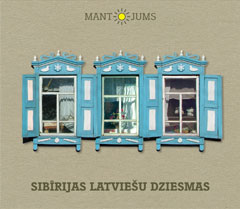
Latvians are scattered throughout the world for various reasons. One of the most remote parts is Siberia. The first Latvians ended up in Siberia in the middle of the 19th century as deportees, later many emigrated to the region hoping to start a new life with the promise of cheap or even free land. In the 1940s and 1950s the biggest influx was those who were deported to the far east by the Soviets. Consequently, Latvians can be found in villages and towns all over Siberia.
Assimilation into the local Russian and other national communities was inevitable. A large proportion of descendants of the original Latvians and Latgalians do not speak their native language or remember traditions, although there have been a few very resilient villages where the culture has survived well into the second and third generations. It is their story that is presented in the audiovisual collection Sibīrijas Latviešu dziesmas.
Since 1975 individual enthusiasts from Latvia have been keen to document for future generations the culture and language of these stalwarts who, defying all odds, still not only speak the language of their forefathers, but also have a mental repertoire of their cultural heritage.
Sibīrijas Latviešu dziesmas is the result of many decades of meticulous work, criss-crossing the Siberian landscape during expeditions to these far-away villages. The beauty of this double-disc edition is the audio and visual elements. Not only can you listen to the compact disc and follow the words of the songs in the liner notes, you can also read the translation in either English or Russian. But the best way of capturing the mood of the Siberian villages is the DVD, as the audio format alone can’t conjure up the image of the singers in their home setting.
The audio tracks—52 in total—show the diversity of songs in Siberia. Some are exact replicas of the folksongs or popular songs (ziņģes) still heard in Latvia today, others have variations on the text and melody. Some, it seems, have “frozen in time” and are songs that were sung in Latvia more than 100 years ago and have since changed their form. Other songs are a merging of traditional Latvian and local Russian songs. Others still have been “brought over” to Siberia during the past decades, as teachers from Latvia who have come to these villages have passed on their cultural knowledge.
The liner notes are particularly informative as they give a descriptive overview of the villages, the different ways each was settled and their fate. It’s also interesting to learn from the liner notes about the different people who have been involved in the expeditions to Siberia through the years and the films and books that have been made about the region. An outline of contact with Latvians from Latvia (or lack of it because of Joseph Stalin’s and later repressions during the Soviet era, where virtually all contact was cut off) over the years is also valuable, sketching in the timeline as well as the ebb and flow of Siberian Latvian village life.
Many of the women singing on the DVD and CD have since passed away, so we are lucky to be able to hear the legacy of this generation before it fades and becomes a distant memory. For various reasons, the DVD leaves one with an uncanny feeling. Here we have modern technology that has captured, almost intruded upon, and documented these elderly farming folk, almost in the manner of a Discovery Channel film, but the object of this documentary is Latvians. The oddest feeling comes over you when you see these women, looking pretty much like any scarfwearing, toothless peasant women from a poor farming community somewhere in Russia. But when you listen closely to the text, you realise that you actually recognise the song! The melody may be different and the singers’ deep, monotonous voices may make it slightly more difficult to recognise, but once you get it, a feeling of sisterhood overwhelms you. Our folksongs are one of our main unifying links—whether we sing them in the heat of the Australian sun, or in the Midwest of the United States, in busy smog-filled Shanghai, in the fields of Zemgale or in these remote Siberian villages.
These are all our people, scattered the world over. This realisation overwhelms because with it comes the duty to not let these songs fade. These songs, and the traditions that go with them, accompany a world-view. If this world-view is forgotten, we will merely become one of the many cultures in the world that have been and gone over the centuries.
So wherever we may be, let’s immortalize these songs by documenting them. But not only that: Let’s teach them to the next generation, and let’s not forget to sing them ourselves and learn new ones every year, so that by the end of our lives we have a mental repertoire like these old folk, the Latvians in Siberia.
Details
Sibīrijas Latviešu dziesmas
Various artists
Upe tuviem un tāliem, 2009
© 1995-2024 Latvians Online
Please contact us for editorial queries, or for permission to republish material. Disclaimer: The content of Web sites to which Latvians Online provides links does not necessarily reflect the opinion of Latvians Online, its staff or its sponsors.





To conceive Latvia as a unified community takes time but can be done due now to the modern technologies that allow communications overseas almost instantly. Sacttered throughout the World, yes but still connected culturally, Latvians are an example of Love for the Homeland (Culture)… wherever it is.